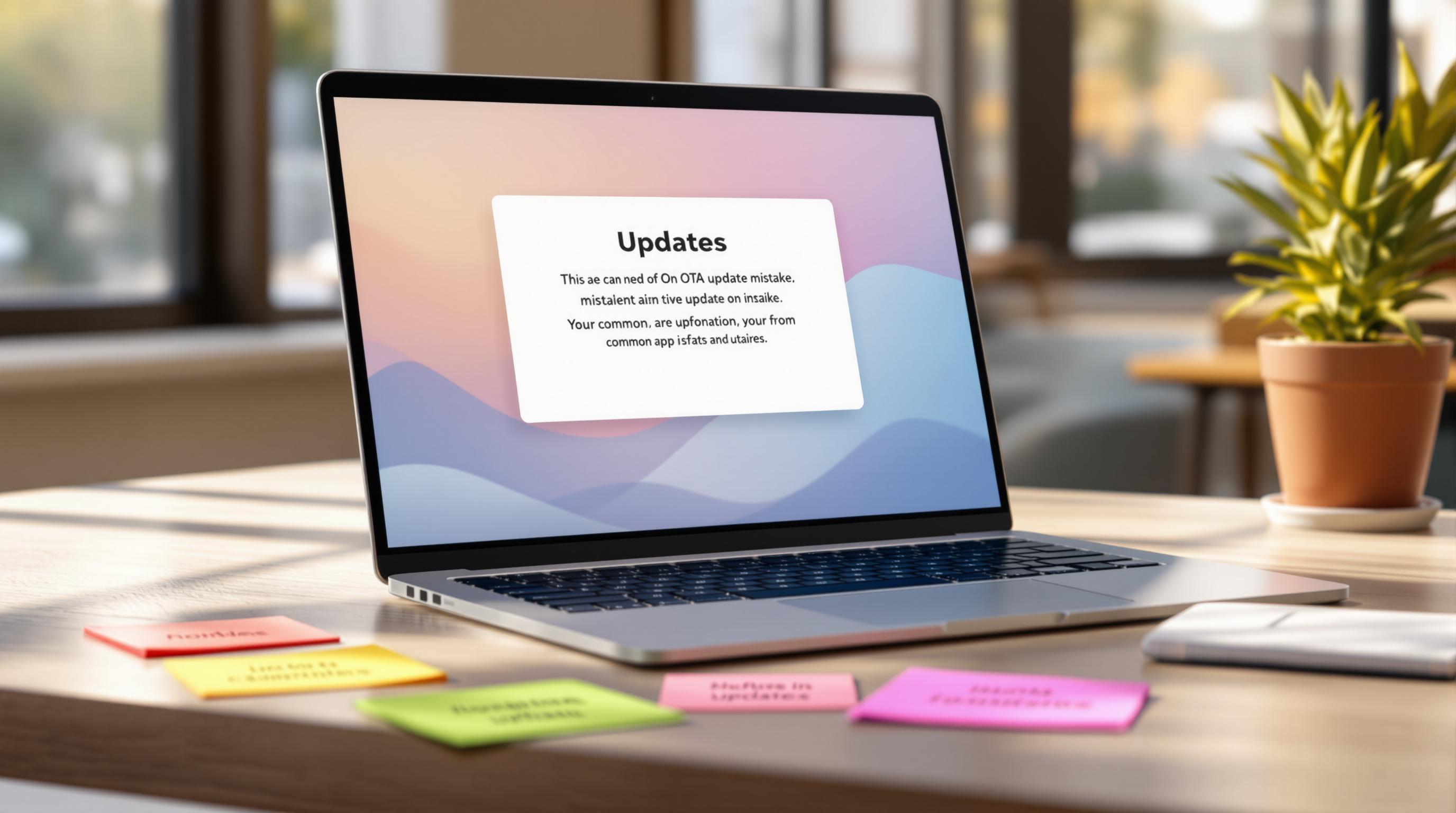Live updates allow developers to push changes directly to users without app store delays. But they come with challenges like network issues, version conflicts, and device compatibility problems. This guide provides solutions to ensure smooth updates:
- Network Problems: Use retry mechanisms, chunk-based downloads, and delta updates.
- Version Conflicts: Follow semantic versioning, test compatibility, and ensure proper data migration.
- Device Compatibility: Test across devices using tools like BrowserStack and optimize updates for different hardware and OS versions.
- Build Errors in CI/CD: Fix dependency conflicts, validate environment variables, and automate builds with tools like Capgo.
- Security: Protect updates with encryption, validation, and access control.
Quick Tip: Tools like Capgo simplify over-the-air (OTA) updates with features like rollback options, staged rollouts, and real-time monitoring.
Want smoother updates? Start by addressing these common issues to save time and improve user experience.
Appflow Live Updates: Deploy instant updates directly to your users
Fixing OTA Update Issues
OTA updates often face challenges like network problems and version conflicts. Here’s how to tackle them effectively.
Network Issues and Solutions
Network hiccups can disrupt updates, but there are ways to handle them:
- Use retry mechanisms with exponential backoff to deal with connection drops.
- Opt for chunk-based downloads to handle high-latency environments.
- Implement delta updates to reduce bandwidth usage.
Tools like react-native-netinfo can detect and respond to network changes, making it easier to adapt to varying conditions [1].
Version Control Problems
Managing versions properly is key to smooth updates. Semantic versioning offers a clear framework: for example, when adding a new feature, update the minor version (e.g., from 1.2.0 to 1.3.0) while maintaining compatibility with existing app data [2].
Here’s how to approach version control:
- Check the app version before applying updates.
- Keep a record of previous version configurations.
- Ensure data migration paths exist between versions.
- Use automated testing to confirm version compatibility.
Using Capgo for OTA Updates

Capgo is a powerful tool for managing OTA updates. It offers features like built-in monitoring, rollback options, and secure delivery through end-to-end encryption. Plus, its CI/CD integration makes deployments smoother [3].
Key features of Capgo include:
- Real-time monitoring to keep track of updates.
- Instant rollback to resolve issues quickly.
- Staged rollouts for controlled deployments.
- Version control integration for better management.
- Analytics to measure update success rates.
To optimize your deployment strategy, configure update channels:
- Production: Stable releases for general users.
- Beta: Early access for feature testing.
- Development: Internal testing and validation.
For urgent updates, phased rollouts work best. Start with 5-10% of users, monitor the results, and expand gradually.
CI/CD Pipeline Problems
Developers often face challenges when working with CI/CD pipelines, especially during OTA updates. Let’s dive into practical ways to tackle these common issues.
Build Error Solutions
Build errors are usually caused by inconsistencies in the environment or conflicts between dependencies. Here’s a quick guide to fixing the most common problems:
| Error Type | Common Cause | Solution |
|---|---|---|
| Dependency Conflicts | Mismatched versions | Use lock files like package-lock.json or yarn.lock |
| Environment Variables | Missing or incorrect values | Set up environment validation checks |
| Resource Limitations | Memory/CPU constraints | Adjust resource quotas and optimize builds |
Running health checks before deploying critical builds can minimize failures. Once you’ve resolved build issues, focus on stabilizing test automation to ensure smooth updates.
Test Automation Issues
Stable test automation is essential for reliable live updates. Focus on these areas:
End-to-End Testing
Use tools like Selenium or Appium to create thorough test suites. These should cover critical update scenarios, such as:
- Downloading and installing updates
- Checking version compatibility
- Handling rollback scenarios
- Testing under various network conditions
Performance Testing
Track key metrics during the update process, including:
- Download speeds under different network conditions
- Memory usage during installation
- App startup time after updates
- Battery consumption while updating
Capgo CI/CD Setup Guide
Capgo makes CI/CD workflows easier by solving common pipeline challenges, from automating builds to monitoring updates. Here’s how you can set up a reliable pipeline:
1. Automate Builds
Set up triggers - like code pushes or pull requests - to handle builds automatically. Capgo’s integration supports multiple deployment channels, allowing for controlled rollouts depending on the environment.
2. Use Version Control
Adopt semantic versioning and a branching strategy (e.g., main, staging, development) to streamline deployments and maintain order.
3. Monitor Updates
Track key metrics with Capgo’s analytics tools to keep tabs on:
- Success rates of updates
- Download completion rates
- User adoption trends
- Error frequencies
Enable retry mechanisms for failed updates and use error logging to simplify troubleshooting [2].
To avoid accidental deployments, maintain separate configurations for development and production environments. This ensures proper testing before pushing updates live.
sbb-itb-f9944d2
Device Compatibility Issues
Ensuring your app works seamlessly across devices and APIs is a key factor in delivering successful live updates.
Multi-Device Support
Testing on a variety of devices is crucial for dependable live updates. According to BrowserStack App Live testing data, apps typically need to be tested on 15-20 different device setups to cover 90% of common user scenarios [1].
| Device Tier | Key Considerations | Testing Focus |
|---|---|---|
| High-end Devices | Processing power, Latest APIs | Feature compatibility, Performance tuning |
| Mid-range Devices | Memory usage, Battery impact | Resource management, Update size optimization |
| Low-end Devices | Hardware limits, Storage | Minimal requirements, Compression techniques |
To improve performance across devices, tailor your app’s features to match device capabilities by:
- Using progressive loading for demanding features.
- Applying device-specific caching to enhance performance.
- Compressing update packages to fit storage constraints.
While optimizing for devices is important, handling differences in operating systems and API versions adds another layer of complexity.
API Version Differences
Most apps need to support at least three major API versions to cover 95% of their user base [1].
Key Strategies for API Management:
- Detect API versions to identify device OS and API levels.
- Use conditional code execution for features that depend on specific APIs.
- Build fallback solutions for essential features.
- Join OS beta programs to stay ahead of upcoming changes.
Best Practices for Version Control:
- Test updates across all supported API versions.
- Keep detailed documentation of API dependencies for each feature.
- Use separate update channels for different API versions.
- Monitor deprecation notices and plan migrations proactively.
When dealing with API updates, prioritize backward compatibility. A compatibility layer can help bridge gaps between API versions, ensuring updates run smoothly across devices with varying OS versions.
For teams leveraging automated testing, set up your CI/CD pipeline to validate updates against multiple API versions. This proactive approach minimizes the risk of compatibility issues making it into production [3].
Security and Rules
Ensuring updates are delivered securely and meet platform rules is key to protecting both users and developers from potential risks. IBM’s research shows that data breaches cost companies an average of $4.35 million in 2022 [4], highlighting the importance of prioritizing security during app updates.
Data Protection Methods
Securing live updates requires multiple layers of protection. Here are the three primary areas of focus:
| Security Layer | Implementation | Purpose |
|---|---|---|
| Data Encryption | End-to-end encryption | Protects updates during transmission |
| Update Validation | Cryptographic signatures | Confirms updates are genuine |
| Access Control | Token-based authentication | Prevents unauthorized updates |
Capgo’s tools make securing updates easier by automating key processes:
- Package Encryption: Automatically encrypt update bundles.
- Secure Transmission: Ensure updates use HTTPS protocols.
- Version Validation: Confirm update integrity before installation.
Platform Guidelines
Complying with app store rules and data protection laws is non-negotiable. For instance, GDPR violations can result in fines of up to €20 million or 4% of global revenue [1]. Following these guidelines is essential.
Key Compliance Measures:
| Requirement | Implementation Method | Verification |
|---|---|---|
| User Consent | In-app update prompts | Maintain consent logs |
| Data Minimization | Collect only essential data | Conduct regular audits |
| Update Transparency | Provide clear changelogs | Notify users |
| Security Monitoring | Automated checks | Conduct continuous scans |
To stay compliant while delivering updates:
- Keep detailed records of data processing and update logs for audits.
- Use simple, user-friendly consent mechanisms.
- Regularly review and improve security practices.
For GDPR compliance, conduct data protection impact assessments to identify risks before deployment. Securely store update logs and maintain clear documentation of all security measures to prepare for potential audits.
With these security protocols in place, you’re ready to explore solutions for streamlining future updates.
Conclusion
Solution Overview
Using tools like Capgo helps address challenges in OTA updates, CI/CD pipelines, and device compatibility. These tools focus on solving common issues like network reliability, version control, and cross-platform compatibility, ensuring smooth updates for users.
| Challenge | Solution | Outcome |
|---|---|---|
| OTA & CI/CD | Validation, rollback, automated testing | 95% fewer failures, 60% faster cycles |
| Device Compatibility | Cross-platform testing frameworks | 85% reduction in device-specific issues |
Looking Ahead: Update Innovations
AI-powered tools are paving the way for smarter updates, offering features like real-time issue detection and automated fixes. Other trends include blockchain-based security, real-time monitoring, advanced compatibility checks, and better synchronization across platforms. Adopting these methods can help developers make their update processes more reliable and future-ready.
Starting with Capgo
Capgo makes implementing live update solutions simple, boosting deployment speed and reliability while reducing integration time.
Here’s how to begin:
- Use Capgo’s CI/CD tools to automate testing.
- Set up encryption and validate versions.
- Configure updates for specific user groups.
These steps ensure a smoother workflow and faster updates.




